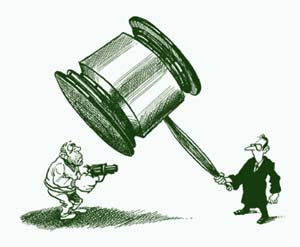- Law & Policy
 Illustration by Ismael Roldan Illustration by Ismael Roldan |
The most important improvement in the conditions of daily living in the United States during the past two decades has been due not to low unemployment or continued prosperity but to the sizable fall in crime. This decline dramatically reduced the fear of becoming a victim on the street, in schools, or in the privacy of homes. Many factors contributed to the lower rates, but the single most important one has been the greater apprehension and punishment of criminals.
The Crime Victimization Surveys of households provide a better picture of the total amount of crime than do the more commonly cited statistics on crimes reported to the police. These surveys indicate that American property crimes per household fell rapidly in the 1980s and 1990s and are now at just half the rate of 1980. Crimes of violence have also fallen but much more slowly.
This large drop in crime is even more impressive because it followed extremely rapid growth in robberies, thefts, and violent crimes during the previous two decades, not only in the United States but in Europe, Latin America, and Africa. Moreover, crime has continued to rise elsewhere, so that per capita property crimes are now higher in many European countries than in the United States. In a remarkable turnabout, the burglary rate in England went from half the American rate in 1980 to double that rate in 1995.
Many international organizations avoid meeting in such cities as Mexico City or Rio de Janeiro because they cannot guarantee the safety of participants. Not long ago, one of my colleagues and his wife were kidnapped for a few hours after hailing a cab in front of a Mexico City restaurant.
FAR FROM HELPLESS
Conservatives blame the growth in crime since 1960 on the breakdown of family values and morality, whereas liberals attribute it to unemployment and alienation from society. But the United States is a good counterexample to both views since crime grew rapidly during the 1960s and 1970s, when American unemployment was low and families were stronger. Crime rates have fallen since the early 1980s, despite a widening of income inequality, a further breakdown of traditional families, and no obvious recovery of morality.
It is not necessary to wait until improvements in education and morality bring down crime rates. They can be quickly cut by apprehending criminals and sentencing them to prison.
Most nations act as if they are helpless in the face of powerful forces to arrest what they consider a crime “epidemic.” But America’s experience indicates that crime can be fought while preserving political and other freedoms. It is not necessary to suffer through a long wait until improvements in education and morality bring down crime rates. They can be quickly cut by increasing the apprehension of criminals and by sentencing those convicted of serious crimes to significant prison terms.
NO PARADOX
Studies by the economist Steve Leavitt of the University of Chicago and others show that the increase since 1980 in the courts’ propensity to convict and imprison criminals made a major contribution to the sizable fall in U.S. crime. Persons behind bars cannot commit crimes against the public, and many people have been deterred from a life of crime by the increased prospect of spending a considerable time locked up. A New York Times headline several months ago proclaimed that “Prison Population Growing although Crime Rate Drops,” but this “paradox” disappears once it is appreciated that the growth in prisoners helps reduce crime.
The U.S. prison and jail population has grown to more than 1.7 million, about 1 percent of the adult population. A sad commentary on modern morality is that so many people must be jailed to bring crime down to more tolerable levels. It is also highly disturbing that black men are eight times more likely to be imprisoned than white men, which reinforces the need for better education and a more stable family life among blacks. At the same time, however, poor blacks and inner-city residents have benefited the most from the greater imprisonment of persons committing serious crimes since they are most often the victims.
Some intellectuals have perpetrated an enormous myth—and delayed effective policies against crime—by claiming that crime is not deterrable, that it is related in an unbending way to poverty, and that it can be reduced only by drastic social reforms. In fact, the United States has shown that the poor and others can be deterred from crime by stacking the odds against criminals.
Countries that develop an effective system of apprehension and punishment of criminals won’t have a magic weapon against all crimes. But they will greatly improve the daily conditions of life for the vast majority of their citizens.







